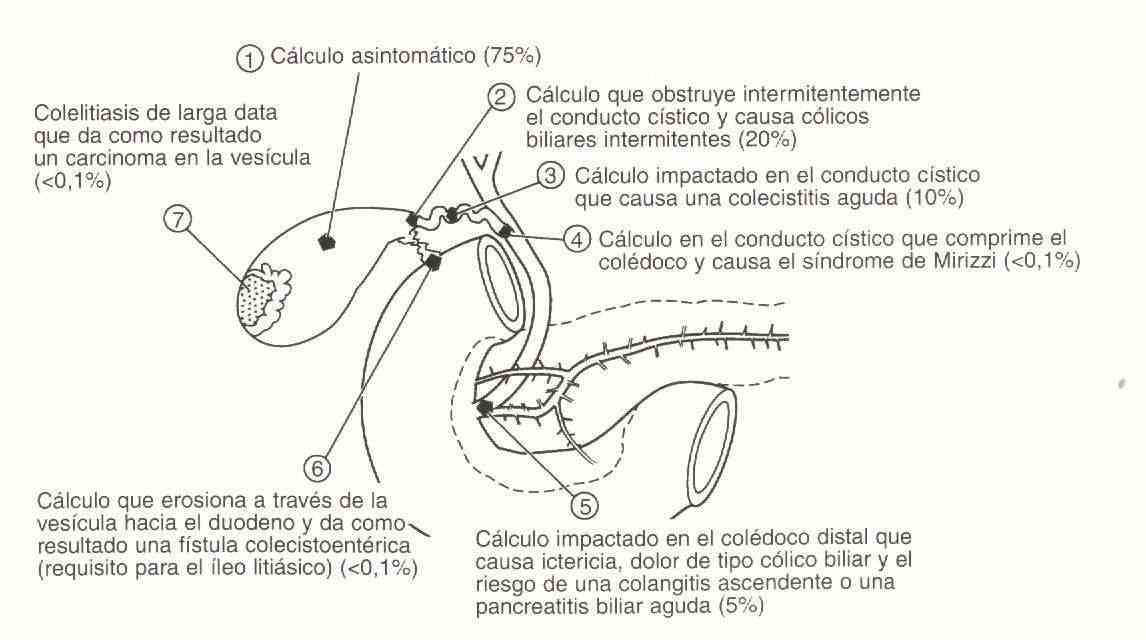Estrada Seminario Ronald Ricardo
Gallstones are a major cause of morbidity throughout the world, cholecsystetomy is the elective abdominal operation that is most frequently performed.
Pathophysiology
Gallstones are crystalline structures formed by the concretion or accretion of normal or abnormal constituents of bile.
In 80% of cases these stones are cholesterol or mixed, and pigmented in the remaining 20%. In general, gallstones are two to three times more common in women than in men, and at least 10% of the population has gallstones.
Cholesterol and mixed stones contain 70% cholecterol monohydrate with calcium salts, bile acids and pigments, proteins, fatty acids and phospholipids. Pigmentaries are composed of calcium bilirubinate. There are several factors that intervene in the formation of gallstones: the most important is the increase in biliary secretion of cholecterol, as seen in obesity, diets rich in cholecterol and with some caloric content, certain drugs (clofibrate) or hormones (estrogens), increased activity of the menopausal gonadotropin himana - Co A reductase or of the enzymes that promote cholesterol synthesis, genetic factors, sex, age, hemolysis, alcoholic cirrhosis.
Rapid weight loss is a more recently recognized risk factor for the development of cholesterol gallstones. About 25% of obese patients who are subjected to strict dietary restriction develop gallstones. The mechanism by which rapid weight loss causes gallstones to form is multifactorial. Many researchers have shown that hepatic cholesterol secretion increases in the case of caloric restriction. Other factors may include increased mucin production (a potent stimulator of cholesterol crystal nucleation) and decreased gallbladder motility.
There are three major defects that are intimately involved in gallstone formation: cholesterol supersaturation, accelerated nucleation, and gallbladder hypomotility.
There is a cholecterol / bile acids relationship that is maintained in an equilibrium whose alteration increases lithogenic activity. One of the factors that alter it is the impediment of the hepatic conversion of cholesterol to bile acids. The majority of bile acid lithiasic patients.
Another significant abnormality is a deficiency in vesicle formation.
An important factor is the nucleation of cholesterol monohydrate crystals, which is very accelerated in lithogenic bile in humans, which may be due to an excess of aggregating (increasing) factors that promote the nucleation of particles or a deficiency of factors that inhibit it. Among the former are mucosal glycoproteins; among the inhibitors of the nicleation are the apolipoproteins A1 and A2. Another mechanism is the increase in biliary sludge made up of crystals of cholesterol monohydrate, lecithin - cholesteroil and calcium bilirubinate. The increase in biliary sludge configures a pre-lithogenic state, which implies the breakdown of the balance between the secretion and elimination of mucin by the gallbladder. By last,
Symptoms and signs
The symptoms and signs of gallstones are associated with mechanical obstruction or inflammation. The characteristic picture is the colicohepatico. By obstructing the exit path of the gallbladder, an increase in intracavitary pressure occurs, to which infection (cholecystitis) can be added. Colic begins after a high-fat intake ("positive patty or egg sign"). It is an intense, sustained pain, located in the right hypochondrium and epigastric with frequent irradiation to the interscapular area or right shoulder, usually of rough beginning, which can improve in two to four hours. It can be accompanied by nausea and vomiting, and if it improves, pain persists in the right upper quadrant.
The laboratory is generally normal, the increase in bilirubin, alkaline phosphatase or amylase suggests coexisting choledochal stones.
Jaundice with coluria and hypocolia may appear as a manifestation of a sustained obstructive condition. The presence of fever or chills suggests an added infection (cholecystitis or cholangitis).
Gallstones can be an occasional finding in a complementary study, without previous symptoms, or in other opportunities it may present with a history of indigestion, nausea, belching, postprandial abdominal distension, irregular presentation of diarrhea, all symptoms that are not clearly related to the existence of lithiasis. The asymptomatic patient rarely develops complications related to his lithiasis, not so the patient with clinical manifestations.

Study methodology
Direct abdominal radiography . Calcified stones can occasionally be seen, as well as a regional ileus in acute colectitis.
Oral colcystography . It is useful for its low cost to identify the presence of gallstones. It allows studying the function of the gallbladder wall, which does not exist in case of disease.
Ecografia . It is the procedure of choice to detect gallstones. It can show the presence of very small stones.
Gallbladder ultrasound should be done after a fast of at least eight hours because the stones are best seen in a distended gallbladder filled with bile. The diagnosis is based on the finding of echogenic objects within the lumen of the gallbladder that produce an acoustic shadow.
Finally, ultrasound has a substantial utility in the diagnosis of acute cholecystitis. Pericholecystic fluid, when seen in the absence of ascites, and thickening of the gallbladder wall to more than four millimeters are nonspecific findings suggestive of acute cholecystitis.
Endoscopic retrograde cholangiopancreatography . It is used for diagnostic and therapeutic purposes.
To evaluate a patient with gallstones, it is important to define by questioning the presence or absence of current symptoms, as well as a history of manifestations or complications related to lithiasis. The size of the gallstones, their number, their radiological density, as well as the function of the gallbladder wall, are elements of great clinical value for evaluating subsequent behavior.